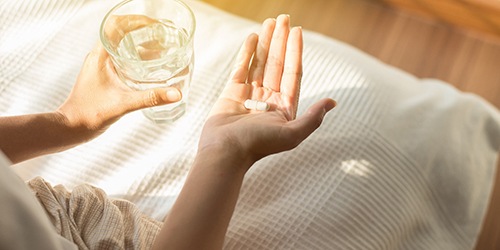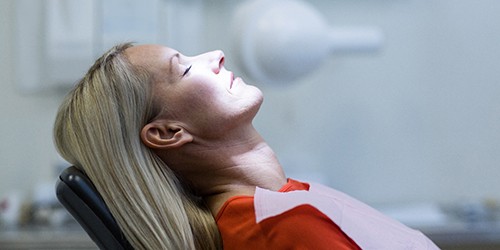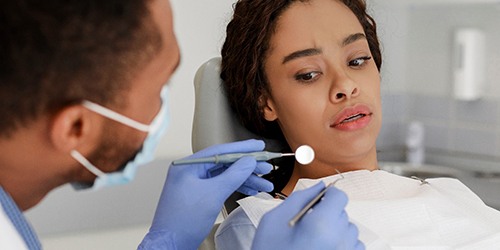Sedation Dentistry – Flower Mound, TX
Helping Anxious Patients Feel More Comfortable

Countless adults feel fear, anxiety, and nervousness when they visit the dentist’s office, which is why sedation dentistry has become such an important aspect of care at our dental office. We want everyone who visits us to feel comfortable and at-ease so they can build a more positive relationship with their oral health. If you have dental phobia or would like to learn more about how sedation dentistry from our Flower Mound, TX dentist can help you have a more enjoyable experience at our dental office, don’t hesitate to reach out to our team.
Why Choose Lauri Barge, DDS for Sedation Dentistry?
- Understanding & Friendly Dental Team
-
We Accept
Dental Insurance - Dentist with Extensive Post-Graduate Training
Oral Conscious Sedation

Oral conscious sedation is a great option for patients who feel anxious leading up to their visits and have more moderate fear, anxiety, or overstimulation. Before your appointment, we’ll prescribe you a pill to take that will help you feel more at ease by the time you reach our dental office. Because the effects of oral sedation linger, you’ll need to be prepared by having a trusted friend or family member drop you off and pick you up from your appointment.
What Is Oral Conscious Sedation?

Oral conscious sedation is generally recommended for adults who have anxiety, fear, or something else that makes them feel uneasy or uncomfortable in the dental chair. There aren’t any needles or face masks involved. Instead, you are prescribed a small pill to take about an hour before your appointment. By the time you get to the dental office, you will be perfectly relaxed.
How Does Oral Conscious Sedation Work?

Once the effects of the medication kick in, you will feel deeply relaxed. Some patients don’t even remember their visit. However, you will remain conscious throughout the whole treatment, so you will still be able to answer questions and follow the instructions of your dentist. We will closely monitor your vital signs to ensure that you are safe. Unlike nitrous oxide sedation, the effects of oral conscious sedation linger, so you should arrange for a trusted friend or family member to take you to and from your treatment.
Are You a Good Candidate for Oral Conscious Sedation?

Oral conscious sedation is popular because it is highly effective, but doesn’t involve a mask or needles. You are likely a good candidate for oral conscious sedation if you:
- Have dental anxiety or phobia
- Regular cancel appointments due to fear
- Have a sensitive gag reflex
- Are having multiple procedures at once
- Have a long dental treatment
- Have difficulty sitting still
- Struggle to become numb from anesthesia
- Have had negative dental experiences in the past
Nitrous Oxide Sedation

If you’re wondering why you haven’t heard of nitrous oxide before, it’s likely because you know it by a different name: laughing gas. This incredibly safe and highly effective type of sedation is suitable for patients of all ages, which is one of the many reasons it’s so popular. If you’re interested in learning all about this calming solution, you’re more than welcome to bring your questions to our Flower Mound dental team. You can also read on to learn more in the meantime!
Who is a Good Candidate for Nitrous Oxide?

As we mentioned above, nitrous oxide is suitable for children and adults alike. Most often, it’s used when patients have a sensitive gag reflex, struggle with mild dental-related anxiety or fear, or are overstimulated by the sights and sounds of the dental office.
There are some cases where nitrous oxide isn’t the best option. For example, if you have asthma or another condition that makes it difficult to breathe through your nose, then this calming solution isn’t ideal because that’s how it’s administered. Rest assured, we can explore the other types of dental sedation if that’s the case, like oral conscious dental sedation.
How Does Nitrous Oxide Work?

Nitrous oxide sedation is administered in-office. After you’ve settled in the treatment chair, we will put a small nose mask in place that allows you to breathe in a colorless, odorless gas. After a minute or two, you will begin to feel the effects set in. Patients commonly describe it as a feeling of lightness, relaxation, and euphoria. Since you’ll be awake, you can easily respond to check-in questions as well as verbal cues. You can even ask for the nitrous oxide to be adjusted up or down as needed.
Aftercare for Nitrous Oxide

After the treatment is finished, we’ll let you know before gently removing the mask. Then, we’ll sit with you while the effects dissipate. Usually, this happens in a matter of minutes (which is another reason patients love nitrous oxide so much). Since there isn’t any lingering grogginess to worry about, you can resume your usual day-to-day activities immediately following your appointment.
Sedation Dentistry FAQs

Do you have concerns about trying sedation dentistry? It’d be normal if you do, as the service isn’t required like other procedures. You might even need clarification, thinking sedation seems scary or confusing. Luckily, the team at Dr. Barge’s office is here to help: below are the answers to some frequently asked sedation questions. Read them to learn what to expect from your sedation dentist in Flower Mound. Of course, you can also get details by calling our office or setting up a consultation .
Am I a good candidate for sedation dentistry?
The best sedation candidates are those with dentist-related fears. If you put off dental work out of fear, you might benefit from dental sedatives.
That said, anxiety isn’t the only reason to undergo sedation. The option is also helpful if you have low pain tolerance, a sensitive gag reflex, or difficulties sitting still. It’s ideal, too, for lengthy treatments that involve several procedures in one sitting.
Still, keep in mind that certain conditions can interfere with sedation. For example, patients who’re pregnant, diabetic, or taking certain medications might not be good candidates. You should thus review your medical history with a dentist, as they can confirm if sedation is right for you.
Is sedation dentistry safe?
For most patients, sedation dentistry is a perfectly safe option. In fact, our office’s nitrous oxide sedation is one of the safest approaches possible.
You see, dentists take proper precautions when using sedatives. Before even deciding on sedation, they’ll go over your medical history and medications to see if there’d be negative interactions. Furthermore, a dentist and their team will monitor your vitals while you’re sedated. That way, they can always confirm that your blood pressure, oxygen levels, and so on are stable.
Will I remember anything with dental sedation?
Dental sedation’s effect on your memory depends on the sedative used. In some cases, then, it can leave you remembering everything, while others give you short-term amnesia.
For example, consider our office’s nitrous oxide sedation. This option uses a mild “laughing gas,” so it doesn’t cause memory loss. It won’t even put you to sleep, either.
On the other hand, oral conscious sedation has a stronger effect. It produces a more intense relaxation and leaves you with little memory of your visit.
How long does dental sedation last?
Dental sedation’s duration (like its memory effects) varies based on the kind you receive. Some sedatives wear off quickly, and others last a bit longer.
With nitrous oxide, the effects should fade minutes after you’ve stopped inhaling the gas. Therefore, you’ll likely be fine driving home or working after your visit. You won’t even feel any lingering drowsiness.
Oral conscious sedation, though, is a bit different. Unlike nitrous oxide, the pill’s effect will remain active for the rest of your day. As such, you’ll need to avoid driving or operating machinery for 24 hours after the procedure. You can compensate by having a friend or family member drive you home following treatment.
